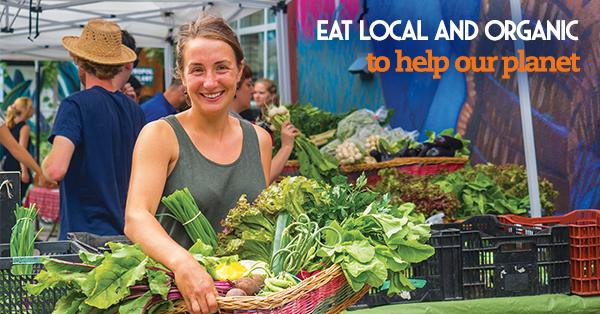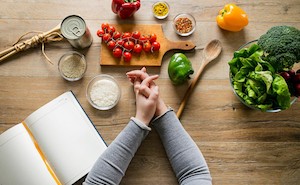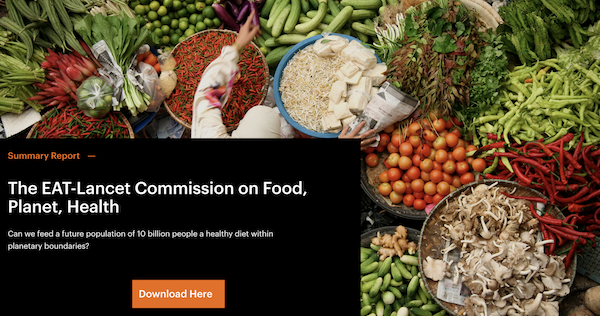Published on
White rice or brown rice? Chicken or tempeh? Organic or local? Vegetarian or vegan? Habits change, and questions like these, which hardly ever used to come up, are now guiding our food choices. 2019 science cannot be more clear: healthy eating for humans is also healthy for the planet.
It was the EAT-Lancet Commission, which in early January laid out the basis for this modern “planetary” vision of food. This commission on nutrition, spearheaded by the famous British science review The Lancet, has joined forces with organizations such as the UN, various environmental and citizen-led groups, and even the new Canada’s Food Guide, in bringing about a real revolution in food.
A “food revolution” in two stages:
- Nutritional choices are one simple and effective way of making a sustainable transition to organic.
- A healthy diet should include not only fruits and vegetables and whole grains, but also protein derived primarily from plant sources.
Équiterre recognizes the accessibility and adaptability challenges in being able to make food choices that are good for our health and good for the environment. Here are a few simple actions that everyone, regardless of income, can take to achieve this!
ACTION No. 1: AVOID THE LOSS OF NUTRIENTS
Eat real food, not empty-calorie, processed products. Équiterre makes this the first step toward a healthy diet.
- Avoid spending money on empty calories—potato chips, pastries, sweets, commercial breakfast cereals, pop, etc.
- Look for food items in their whole form, such as whole grains, proteins, nuts, pulses, fruits and vegetables. Opt, for example, for brown rice instead of white rice for more protein and fewer carbohydrates.
- Consider choosing products for their natural nutritional content: for example, choose to eat your potatoes boiled, instead of fried or processed into chips!

ACTION No. 2: IF YOUR BUDGET ALLOWS, CHOOSE LOCAL ORGANIC FOODS AND ORGANIC BASKETS
In addition to meeting our nutritional needs, healthy food items “should be understood as coming from food-production systems that sustain our natural resources, increase the well-being of our animals and sustain the overall health of communities and cultures.” (Food Secure Canada)
In Quebec, this is possible by choosing food that is certified organic and local. This means you can be sure that the food is full of freshness, flavour and nutrients, all while supporting local farmers who have decided to farm their land without the use of pesticides, synthetic fertilizers or genetically modified organisms (GMOs), and who market their products through local channels.
Équiterre has been creating awareness about the benefits of putting local, organic foods on our plates since it established the Family Farmers Network in 1995. There is still work to be done to make organic foods accessible for all budgets. But did you know that organic baskets are generally less expensive than the local organic fruits and vegetables sold in your grocery store? (More details on organic baskets subscriptions)
- Incorporate organic foods one step at a time, within your means, starting with those that are listed as containing the most pesticides.
- Learn how to recognize products that are certified, ensuring that they are approved by the Conseil des appellations réservées et des termes valorisants (CARTV).
- If you are unable to purchase organics, try to ensure that the food you buy is local.
- Take advantage of the summer and harvest periods to purchase larger quantities of local organic fruits and vegetables and preserve or freeze them: that way you will be able to enjoy them in the off-season at a lower price or with a lighter footprint than buying them at the grocery store.

ACTION No. 3: LEARN ABOUT THE GHGs EMITTED BY THE PRODUCTION OF MEAT AND OTHER TYPES OF PROTEIN IN ORDER TO GUIDE YOUR CHOICES
Protein from sources other than plants, especially that produced in raising farm animals, is the primary source of greenhouse gas emissions (GHGs) in the farming sector. The impact that cattle farming has on global warming can be explained by the property of cattle digestive systems which emit methane, a gas that is 25 times more harmful to the climate than CO2. For example, the carbon footprint of beef cattle accounts for one-half of the GHGs associated with animal farming. Here is the number of kg of CO2 emitted in producing one kg of food:
- Lamb 39 kg
- Beef 27 kg
- Cheese 13 kg
- Farmed salmon 13 kg
- Pork 12 kg
- Chickens 7 kg
- Vegetables 2 kg
- Fruits 1.1 kg
Source : Food Watch
In addition to their many health benefits, plants have certain characteristics that allow food production to be adapted to climate changes (they provide essential micronutrients such as iron, zinc, folate, Vitamin A and calcium).
- Prioritize the consumption of vegetable-based proteins such as lentils, tofu, soya tempeh, millet and vegetable oils, and a variety of other plants.
- Minimize your consumption of red meat. Eat-Lancet recommends the equivalent of one hamburger per week. Also, when you buy meat products, try to ensure that they come from a certified organic farm.
- Greatly reduce your consumption of seafood that is produced through non-sustainable fishing practices because these contribute to a degradation in the health of the oceans and reduce their productivity.

ACTION No. 4: DEVELOP YOUR KNOWLEDGE OF “EATING WELL”
Eating healthy also involves adding to your culinary knowledge: learn where food comes from, how it is produced, and how to prepare, cook and enjoy it.
Équiterre has initiated a number of projects to educate and encourage people to change their food habits: Aliments du Québec au menu (in cafeterias), Écoles enracinées (fundraising campaigns through the sale of organic baskets), educational workshops in schools, the teacher’s kit on food and the Family Farmers Network. Here are a few tips for developing your food knowledge:
- Discover our recipe cards that showcase over 50 Quebec fruits and vegetables (and find out how available they are!)
- Learn to cook using new foods, such as sprouts, or how to benefit from the nutritional benefits of potatoes when used for something other than being turned into junk food;
- Explore the different ways to prepare all parts of a food item: look for a recipe that uses radish tops to create nutritious salads, carrot tops to make excellent soups, fennel fronds to make aromatic broth or strawberry tails to make tasty syrups!
- Those who are more adept can learn about the microbiotic diet, master fermentation, or discover insect protein.


IN MARCH: Let's get going!
March is Food Month. Take advantage of the opportunity it to make small changes in your food habits!
The time has come to eat in such as way that there is less impact on our bodies and on the planet. Choose a diet that includes nothing less than what is healthier, more natural and more sustainable. It’s possible—one action/one meal/one mouthful at a time :)





